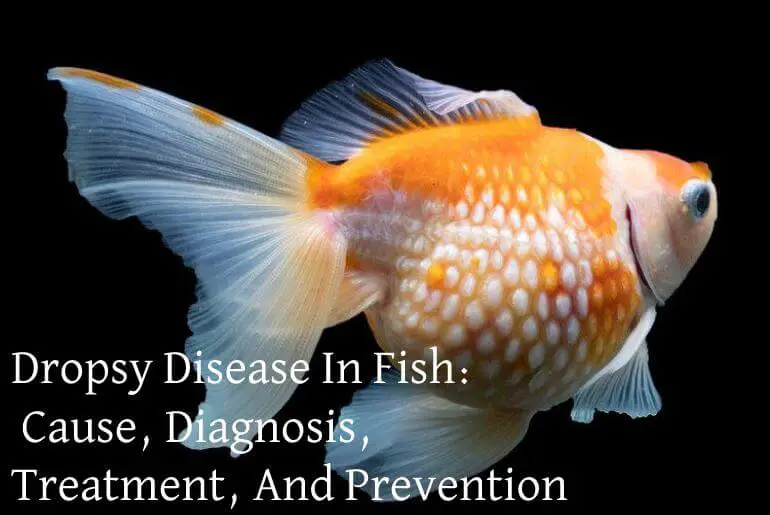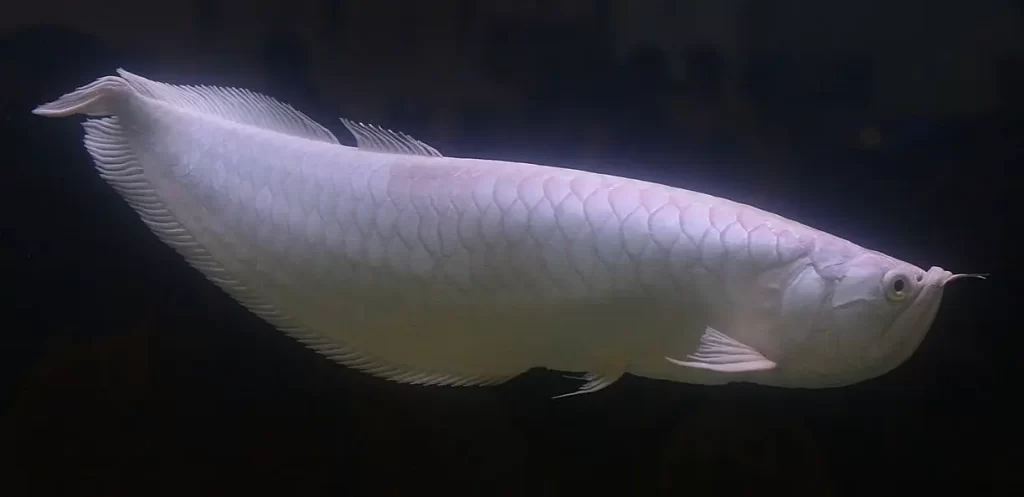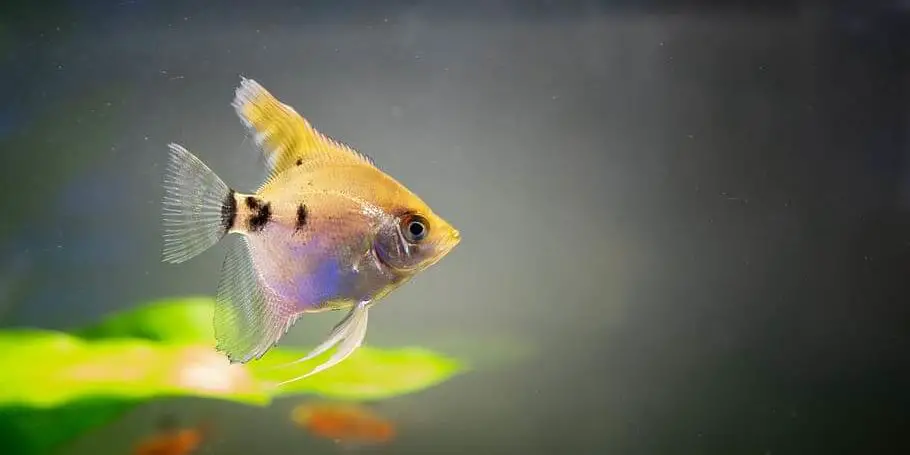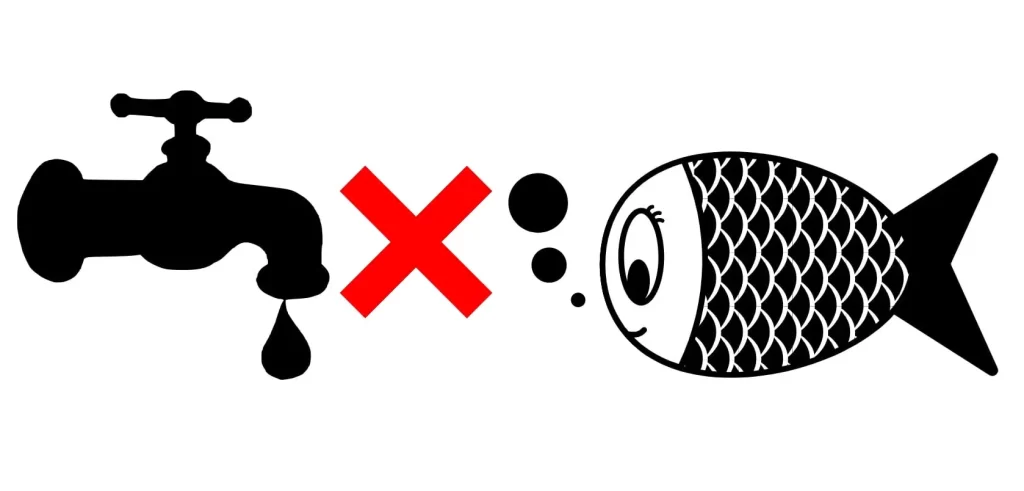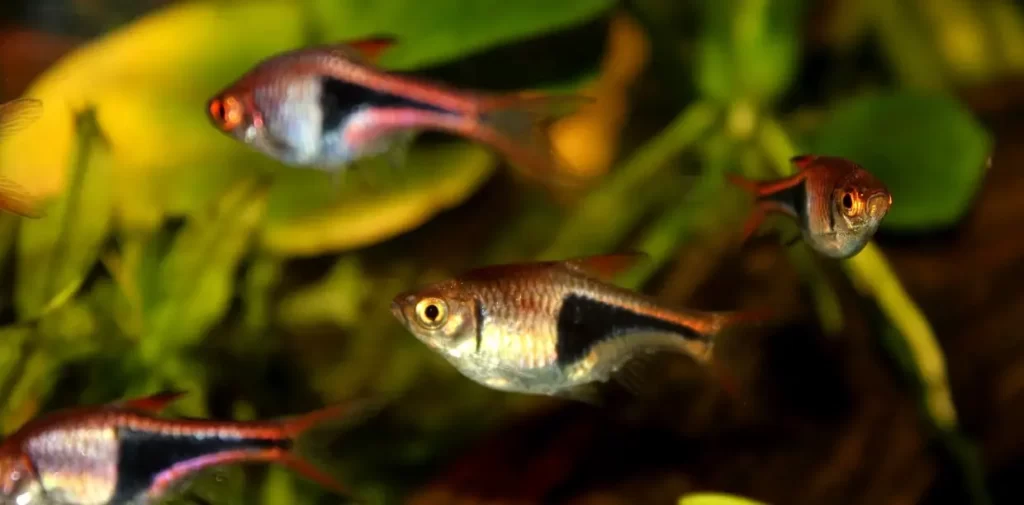As you love your fish pet, you don’t like seeing them suffer from any fish illness or disease, mainly from Dropsy. Many aquarists mostly fear this disease as only a few fish succeed in surviving through it. So, it is significant for you to know about Dropsy disease in fish: cause, diagnosis, treatment, and prevention in detail. Here, in this article, you will have every settled information regarding it.
Dropsy disease in fish is a disease where the fish belly swells bulky, ending in their whole belly area dropping down. You can say your fish has Dropsy if their belly swells, fins, and skin turn red, losses appetite, their eyes bulge out, and their scales stand out. Dropsy usually troubles those fish who have a weak immune system or are already ill. But don’t worry! This disease is treatable if you observe the symptoms on time. Also, preventing Dropsy in fish is possible.
However, I have seen much-unsettled information regarding Dropsy disease everywhere. Thus, by aiming to signify you precisely to protect your fish from this disease, let’s know in broad details about it.
Introduction To Dropsy Disease In Fish
Dropsy disease in fish is so common and old that it originated since the fish-keeping practice begin.
The term ‘Dropsy’ refers to explain the swelling happening in the abdomen area of the body. Similarly, Dropsy fish disease refers to the state where their stomach swells to the extreme.
Precisely, Dropsy in fish is not a disease or extreme virus itself, but a bacterial infection. The bacterial infection then causes the swelling of the fish abdomen, which refers to a Dropsy disease. Here, this disease may also imply some underlying parasitic illness and sometimes liver dysfunction.
Besides, dropsy disease spots mainly in the fish abdomen as the water and other fluids accumulate there. Due to this reason, it makes the bacterial infection swell their belly right away specifically.
Causes Of The Dropsy Disease In Fish
As stated, Dropsy is not a virus or disease but a consequence of a bacterial infection. Thus, it is pretty clear this disease in fish occurs when the fish are in the presence of bacteria. But where do these bacteria exactly exist?
Bacteria usually exist in every aquarium. It may be surprising to hear it, but it is true. Their existence in the fish tank is pretty evident. But such bacteria become infectious to those fish only who are already sick or stressing over certain circumstances in the aquarium.
Such aquarium circumstances can make the healthy life of fish disbalance. It can be some leading cause of Dropsy disease as the chance of bacterial infection rises.
Some of the causes of Dropsy disease are:
Poor Water Quality
One of the main reasons for aquarium fish to stress is due to the poor water quality.
Fish do require fresh and clean water quality not just to thrive but breathe purified oxygen. It gives fish a comfortable environment where they can live in wholesome.
If the water quality in the aquarium gets poor, fish will not receive proper oxygen supplements and freshwater levels. It puts the fish in an uneasy and confused state, which stresses them.
Once the fish starts stressing due to poor water quality, the bacteria present in the aquarium have a high chance of affecting them. While stressing over poor water quality, the fish may not protect themselves by keeping stable physical and mental health. It can create a chance for Dropsy to infect them.
Thus, poor water quality in the aquarium stresses the fish that can cause Dropsy disease.
Change In Ammonia And Nitrate Levels
In the aquarium, the only right amount of ammonia and nitrate benefits the fish. In case of any change, the fish will suffer.
When you first add fish to the aquarium without performing a complete nitrogen cycle, the fluctuation in ammonia and nitrate is then predictable.
Even the tiny change in ammonia and nitrate level can stress your fish as it affects their gills. At extreme levels, it gets deadly state as it results in ammonia poisoning and nitrate poisoning.
In such conditions in the tank, the fish tend to fall sick or at least weak. Such an environment results in the poor lifestyle of the fish, where the possibility of bacterial infection in them rises.
Due to the change in ammonia and nitrate levels, there is a high possibility for fish to get Dropsy as their body becomes much weak.
Unhealthy Diet
A healthy diet is an indispensable factor in the survival of aquarium fish. However, the diet can also be toxic if given harmful food and an over or inadequate diet.
Just like in humans, some food is avoidable to them to maintain their good health. Such an unhealthy diet makes the fish weak, inactive, and eventually sick.
When the fish body slowly starts draining due to unhealthy diet intake, Dropsy disease is likely to infect them. A weak body is at a high risk of this disease as the bacteria can target them easily.
Temperature Drop-In Water
Maintaining an ideal temperature for any fish species in the aquarium is significant. Any fluctuation in the water temperature can put fish in trouble as their survival would be at risk.
As their whole life is dependent on the water, a drop in the temperature creates a difference. It makes the fish nervous, dull, and anxious as the situation would be very uncomfortable for them.
In this situation, fish usually stresses as their survival would be problematic here. Such stress can make them mentally very weak, which often causes bacteria to lead on them. Eventually, it becomes a cause for Dropsy in the fish.
Aggressive Tankmates
While selecting tank mates for your fish in the aquarium, it is essential to analyze their compatibilities. Otherwise, you might make a mistake by choosing such tank mates who can get aggressive and bullying.
Aggressive and offensive tank mates annoy and disturb other fish, which makes the tank environment poor. The fish will stay unwillingly with such aggressive tank mates that can stress them in the large. Sometimes, some fish tend to fall sick as they might not bear the threatening and aggressive action for a longer time.
Eventually, the stressed fish are likely to get infected by Dropsy disease as the bacteria present in the aquarium can attack them quickly.
Other Diseases
Another cause for Dropsy disease in fish is some other illnesses in them. Meaning, if your fish is already ill or is suffering from other serious diseases, they are likely to have Dropsy too.
A disease attracts several other illnesses. Similarly, getting ill from the beginning creates a possibility of Dropsy in them. Also, when your fish is undergoing other sicknesses, their immune system gets weaker than in general. There forms a high chance for a bacterial infection to hit them where they will suffer from Dropsy disease.
Symptoms Of Dropsy Disease In Fish
Identifying Dropsy disease in fish is not difficult but not that easy too. One of the foremost symptoms that you can see in fish is their belly swelling due to the accumulation of water and fluid.
Apart from the belly swelling, there are many other symptoms that you can note in them. It sounds pretty simple, correct? Not really!
Not all the fish suffering from Dropsy disease shows overall symptoms. It is the most challenging part as the Dropsy indication may vary from one fish to another. Some typically show all signs, whereas some show only a few.
Don’t worry! Either the fish shows a few or every symptom, they do hint towards general Dropsy infection. To help you know about the commonly portrayed signs of this disease, I have made a list of them.
So, the symptoms of Dropsy fish disease are:
Swollen Belly
It is one of the most common symptoms that indicate Dropsy in the fish. However, this symptom is bothering too as the stage of belly swelling means a severe degree.
The fish will swell their belly because water and other fluids accumulate in their abdominal area in a large. Also, their spine bends as the fluid pushes the stomach out. It increases and swells in such a way that it looks like the fish has swallowed a marble. Due to the swollen belly, the fish will have a problem while swimming and living peacefully.
Don’t get confused between a swollen belly of fish and enlargement of the stomach during fish pregnancy. A pregnant fish cannot increase their stomach size within a short period, whereas the Dropsy swelling belly is noticeable once the fluid collects in the abdomen.
Scales Stand Out With Pinecone Like Appearance
When the fluid and water start accumulating continuously in the fish body, their skin will grow tight and firm. Due to the firm and rigid skin of the fish, it affects their scales too.
The scales will stand out from their regular plane and resting spot. It will slowly lead the fish scales to appear a disturbing pinecone-like appearance.
Such a pinecone-like appearance of the fish scales is not normal. It is likely to happen when the Dropsy disease is haunting your fish.
Eyes Bulged Out
Popeye is another extreme condition that a fish indicates as a symptom of Dropsy disease.
Popeye is a state where either one or both fish eyes get faded and discolored. It happens when the bacterial infection attack the fish. Here, the increasing fluid makes their eyes bulged out from their face.
Other Symptoms
Generally, the above three symptoms are a quick indication to diagnose Dropsy disease in fish. Yet, there are few more symptoms that you can observe if your fish are suffering from Dropsy.
Some other symptoms of Dropsy disease in fish are:
- Pale Gills
- Fins Clamped Together
- Redness Of The Skin And Fins
- Loss Of Appetite
- Pale And Stringy Excretions
- Inactivity And Laziness
- Hanging At The Surface Of Water
Therefore, these are some symptoms that signify Dropsy disease in fish. If you notice any of the signs, don’t misinterpret them and quickly treat your fish. The early you diagnose the Dropsy disease, the sooner you can help your fish to get through it.
If you disregarded these symptoms and failed to identify their disease, your fish may get into a fatal stage.
How To Treat The Dropsy Disease In Fish?
Treating Dropsy fish disease as soon as you identify the symptoms is vital. It is because the bacterial infection causing Dropsy is not curable quickly. It takes time to cure the Dropsy infected fish, which can be fatal if not treated on time.
So, to treat the Dropsy disease in fish, here are some of the ways that you can follow:
Separate The Sick Fish From Other Fish
The first step to treat Dropsy fish disease is to separate the sick fish from other fish in the aquarium. Keep the infected fish in another separate tank and isolate them. Let’s consider the isolated tank as a hospital tank.
During that, clean the original tank of the fish and monitor the activities of the rest of the fish. See if any other fish has a Dropsy symptom or not.
Keep Osmotic Balance
Once you isolate the infected fish into a separate tank or hospital tank, add one teaspoon of aquarium salt per gallon. Know the tank size per gallon of the hospital tank and put the salt accordingly.
The moderately salty water keeps the osmotic balance of the fish as the water will replicate their blood salinity. It helps to remove the excess water and fluid accumulated in their body.
But be careful, don’t add too much salt by thinking it would cure the fish shortly. It will instead create an unhealthy situation for the fish.
Besides, remember to keep the hospital tank neat and clean. Also, conduct partial water change each week to add salt to another freshwater to treat the infected fish.
Feed Fresh And High-Quality Diet To The Fish
Provide some wholesome and high-quality diet to the infected fish. If your fish is still eating, the condition is still not fatal but in a good state.
Offer them some variety of fish food, but make sure the diet has not expired from the date. You can also feed them some live foods if you have raised them on your own. Live foods purchased only to serve your infected fish can produce bacteria, which you must avoid at their treatment time.
Also, avoid overfeeding the infected fish to provide all high nutritional at once. The fish may not eat as much as they used to because of Dropsy. They will not eat much and leave the food in the tank. Such leftovers will then rot, creating possibilities to form more bacteria.
Test The Water Quality Daily
It is essential to check the water quality of the hospital tank daily to ensure the infected fish is living in a proper environment. The water quality should be fine, pure, and uncontaminated.
To test the water quality daily, you can use a Strip Test Kit.
Clean The Tank Of The Sick Fish
While you add each teaspoon per gallon to the hospital tank, it is significant to clean it regularly. Cleaning the tank makes it suitable to add salt further for curing the infected fish.
You cannot add salt to the tank without partially cleaning the water in a week. It raises the salt level in the tank, which will result in toxicity to the fish instead of the cure.
Thus, cleaning the hospital tank of the sick fish is significant to keep them in a healthy environment.
Increase The Temperature To Few Degrees
While the infected fish is in the hospital tank, it is essential to provide them a warm temperature. It helps to stimulate the digestive, immune, and respiratory functions of the fish.
A warm temperature usually helps the infected or sick fish to boost quickly. Similarly, Dropsy infected fish becomes more capable and active when the tank temperature becomes warm.
For example, if your fish requires approximately 75 degrees Fahrenheit in general, increase the degree up to 79 to 80 Fahrenheit. Likewise, if your fish lives in a temperature ranging 80 degrees Fahrenheit, provide them water degree up to 84 Fahrenheit.
Therefore, an increase in the temperature to few degrees can help the infected fish to cure soon.
Aid With Antibiotics
If your fish is not consuming and answering well with any other treatments, it is high time to aid them with antibiotics. The fish that is not responding to any other treatments is not a good sign. Thus, helping them with antibiotics may be the only option you have left to treat them well.
For this, go for a broad-spectrum antibiotic; Maracyn-Two. It is a powerful antibiotic that treats a broad reach of bacterial infections. It absorbs all the infected bacteria from the skin of the fish and cures them soon.
For proper application, read the instructions mentioned in the antibiotic. Then, add its only specific amount to the water of the hospital tank. Still, if you are unsure about its use, you can consult a vet.
To my knowledge, ten days of practice with this antibiotic results in the best for the infected fish. The bacteria infection and Dropsy indication almost fades after few days of use.
Observe The Fish
Throughout all the treatments to the Dropsy infected fish, keeping your eye on them is crucial. Observing every little detail since isolating them in the hospital tank till the ending of Dropsy indication is significant.
If your fish gets completely fine, observe their behaviors for few more days before you keep them back to their original tank. There may be a slight chance for them to show some Dropsy sign again. If such a situation occurs, it means the aid given to the fish is being inadequate. Treat them finely again.
But after treating every possibility, if you observe no many improvements in your fish, know the condition is fatal. There is nothing you can do now but to seek a vet.
How To Prevent The Dropsy Disease In Fish?
You must be aware of this saying- “Prevention is better than cure.” Following this, it is always better to prevent Dropsy disease in fish than curing them later.
You may wonder that bacteria exist in the tank from the start, so how to prevent Dropsy in fish. It is straight the bacteria exists already in the aquarium, yet the prevention of this disease is likely.
Dropsy disease is preventable before it infects your fish. You must ensure and put some effort into making things work correctly in the aquarium.
So, to prevent Dropsy disease in fish instead to cure it later, you can go through the following ways:
Maintain The Water Quality
When the water quality gets contaminated, the fish would undoubtedly stress. But it also attracts many bacteria and fungal diseases. So, to avoid these situations in the tank, maintaining decent water quality is significant.
For this, change the tank water often without disturbing the fish. Replacing 20 to 25 % of water can remove the toxic elements from the tank. Water change also provides a fresh and clean environment for the fish. Plus, it maintains oxygen levels in the tank, which makes the respiratory process of the fish salutary.
Test The Aquarium Water Regularly
Test the aquarium water at least once a week to know the accurate levels of ammonia, nitrate, and nitrite. Plus, check the other details like water temperature, pH range, and water hardness in the aquarium.
You can use an aquarium thermometer to know the temperature of the water. If you see the water temperature fluctuating, you can get an aquarium heater. This equipment in the aquarium works to maintain the accurate water warmth required for the fish.
Clean The Filter Regularly
Cleaning the aquarium filter is crucial work to perform to balance the tank habitat.
Wash the filter thoroughly to remove residues that block the filtration function from working. To clean the filter, you can use the tank water.
Do not use tap water to clean this equipment as it can kill the beneficial bacteria present inside the filter sponges.
Feed Healthy And High-Quality Diets
A healthy and high-quality diet strengthens the immune system and healthy lifestyle of the fish. You can provide many live foods, pellets, and flakes to them to keep them nourishing.
By consuming such diets, fish in the aquarium are unlikely to get dull and weak. Instead, they thrive better, which shows the strength of the fish to fight against bacterial infection.
Avoid Overfeeding The Fish
While you provide healthy and high-quality diets to your fish, remember not to overfeed them. Intending to supply them with a healthier life, you might be hampering them if you overfed them.
Overfeeding the fish will make them excrete too much in the tank. Such excretion forms more chances for bacteria and fungal diseases to exist and attach them.
Also, there is no certainty that your fish will eat all the diets that you offer them. When offered more food, they tend to leave extras in the tank. The leftovers will then rot in the tank, where the survival of bacteria affecting the fish for Dropsy gets stronger.
Thus, do not overfeed the fish by aiming to supply high nutrition to them instantly.
Avoid Overcrowding The Aquarium
If you add more fish without considering the tank size, the aquarium will get overcrowded. An overcrowding tank makes the fish afraid and nervous as the oxygen levels usually decrease, and the ammonia level increases due to more excretion. If they continue living in such a state, the bacterial infection can target them easily.
Thus, avoid overcrowding the aquarium as such a situation can make the fish dull and stress.
Prevent Aggressive Tank Mates
Aggressive tankmates do make the lifestyle of other fish unfortunate. They threaten and bully other fish in the aquarium, which makes them mentally and physically exhausted. Due to this, the other peaceful and quiet fish lose their activeness as they get stressed out.
So, prevent aggressive tank mates in the peaceful fish aquarium. Before selecting tank mates for any fish, analyze the behavior and know the compatibilities between them.
Maintain Healthy Aquarium Environment
The Dropsy bacterial infection exists already in the aquarium. So, the only thing you can do to prevent it is to maintain a healthy aquarium environment.
For this, you can set the aquarium with an ideal degree where the fish do not lack any necessity. Add some live plants and aquarium decorations to enhance the tank better.
Besides, you can use an aquarium vacuum to remove leftover food, fish excretion, and other trash. Also, separate dead or dying leaves from the tank as they can pollute the fish habitat later.
Thus, maintain a healthy aquarium environment so that your fish gets protected from bacterial infection.
Frequently Asked Questions:
Is Dropsy Painful For The Fish?
Dropsy is a bacterial infection that makes the life of fish worst. It brings several changes in their body, weakens them, and can take them in the mouth of the dead too. Getting through all these phases, including their treatment, would surely make the fish feel miserable. So, yes, Dropsy is painful for the fish.
How Long Does Dropsy Take To Kill A Fish?
Generally, Dropsy becomes fatal within 1-2 weeks. If you fail to see its symptoms in fish and couldn’t treat them on time, the specified duration is enough to kill them.
Is Dropsy Disease In Fish Contagious?
Dropsy in fish typically is not contagious. However, there is a practice of isolating the sick fish in another tank to prevent this disease from spread to other fish. If there is any chance of contagious, mainly the similar species of infected fish are at risk.
Will Dropsy Cure Itself?
No, Dropsy will not cure itself. This disease takes time to heal with proper medication and isolation treatment. They are unlikely to cure if left untreated in the tank. Instead, the fish will die.
Conclusion
The fish disease is one of the worst nightmares being true for many of you, fishkeepers. On top of that, Dropsy disease is something every aquarist fear as it can make the fish fatal.
Dropsy disease swells the fish belly as the abdomen accumulates fluid due to bacterial infection. You can confirm your fish infecting by this disease if you identify some visible symptoms. If you see any, don’t worry and calm yourself! Get into their treatment process quickly to save their life.
However, you can help your fish prevent Dropsy by keeping them strong, boosting their immune system, and maintaining healthy tank habitat. Dropsy disease in fish is dangerous. So, it is better to prevent it instead of curing it.
Keep your fish healthy and happy.

